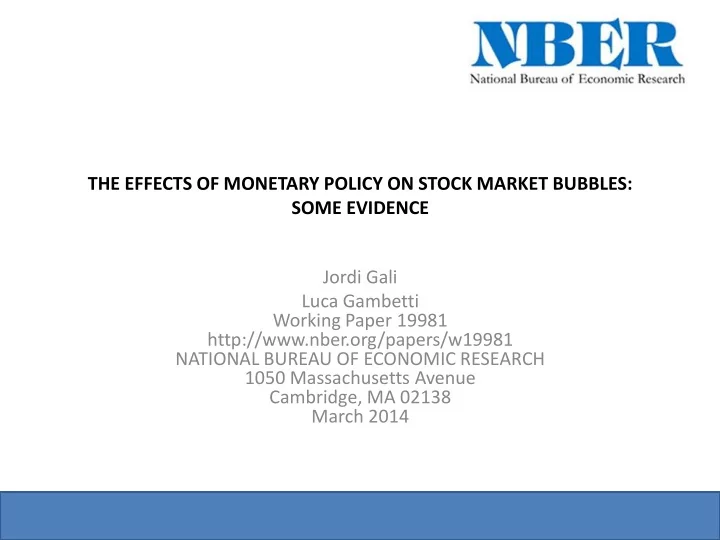

THE EFFECTS OF MONETARY POLICY ON STOCK MARKET BUBBLES: SOME EVIDENCE Jordi Gali Luca Gambetti Working Paper 19981 http://www.nber.org/papers/w19981 NATIONAL BUREAU OF ECONOMIC RESEARCH 1050 Massachusetts Avenue Cambridge, MA 02138 March 2014
Introduction • The economic and financial crisis of 2008-2009 has been associated in many countries with a rapid decline in housing prices, following a protracted real estate boom. • The consensus view before the crisis was that central banks should focus on stabilizing inflation and the output gap, and ignore fluctuations in asset prices, even if the latter are perceived to be driven by bubbles. • A central tenet of the case for "leaning against the wind" monetary policies is the presumption that an increase in interest rates will reduce the size of an asset price bubble.
• While that presumption may have become part of the received wisdom, no empirical or theoretical support seems to have been provided by its advocates. • the theory of rational bubbles implies that the effects of monetary policy on observed asset prices should depend on the relative size of the bubble component. • an increase in the interest rate should have a negative impact on the price of an asset in periods where the bubble component is small compared to the fundamental.
• The reason is that an interest rate increase always reduces the fundamental price of the asset, an effect that should be dominant in "normal" times, when the bubble component is small or non existent. • But if the relative size of the bubble is large, an interest rate hike may end up increasing the observed asset price over time, due to its positive effect on the bubble more than offsetting the negative impact on the fundamental component.
Monetary policy and asset price bubbles: Theoretical issues • We assume an economy with risk neutral investors and a time-varying (gross) riskless real interest rate Rt. Let Qt denote the price in period t of an infinite-lived asset, yielding a dividend stream Dt. • We interpret that price as the sum of two components: a "fundamental" component, QF , and a "bubble" component, QB. Formally,
• where the fundamental component is defined as the present discounted value of future dividends: • rewriting it in log-linear form
• How does a change in interest rates affect the price of an asset that contains a bubble? • Both conventional wisdom and economic theory:
• Then: • Under the "conventional view" on the effects of monetary policy on asset price bubbles we have, in addition:
• As argued in Galí (2014), however, the premise of a decline in the size of the bubble in response to a interest rate hike does not have a clear theoretical underpinning. • the theory of rational asset price bubbles opens the door for a very different prediction. • the following difference equation must hold in a rational expectations equilibrium:
• in its log-linear version: • Hence, an increase in the interest rate will raise the expected growth of the bubble component.
• Changes in interest rates, however, may also affect the bubble through a second channel: • a possible systematic comovement between the innovation in the bubble with the surprise component of the interest rate. • Note that the unanticipated change ("innovation") in the size of the bubble, may or may not be related to fundamentals and, in particular, to the interest rate innovation.
• The dynamic response of the bubble component to a monetary policy tightening is given by
The empirical model • The empirical model, which consists of a structural vector autoregression model (SVAR) • (log) output, the (log) price level, the (log) commodity price index, the short-term nominal interest rate controlled by the central bank, the (log) stock price index, and its corresponding (log) dividend series (both in real terms) • Ordering: • The sample period is 1960Q1 to 2007Q4
Estimated Responses to Monetary Policy Shocks: VAR with Constant Coefficients
Estimated Responses to Monetary Policy Shocks: VAR with Constant Coefficients
Estimated Responses to Monetary Policy Shocks: Analysis of Selected Episodes Dot-com bubble (March 10, 2000) Black Monday (October 19, 1987)
Recommend
More recommend